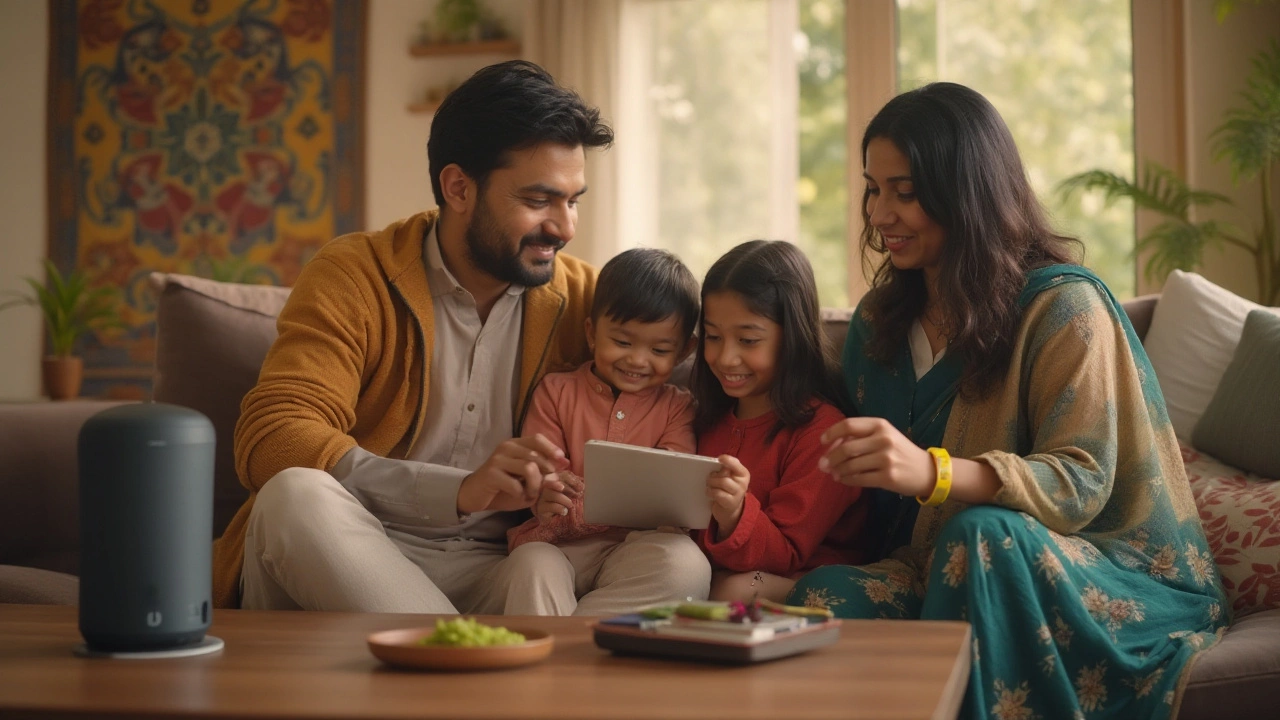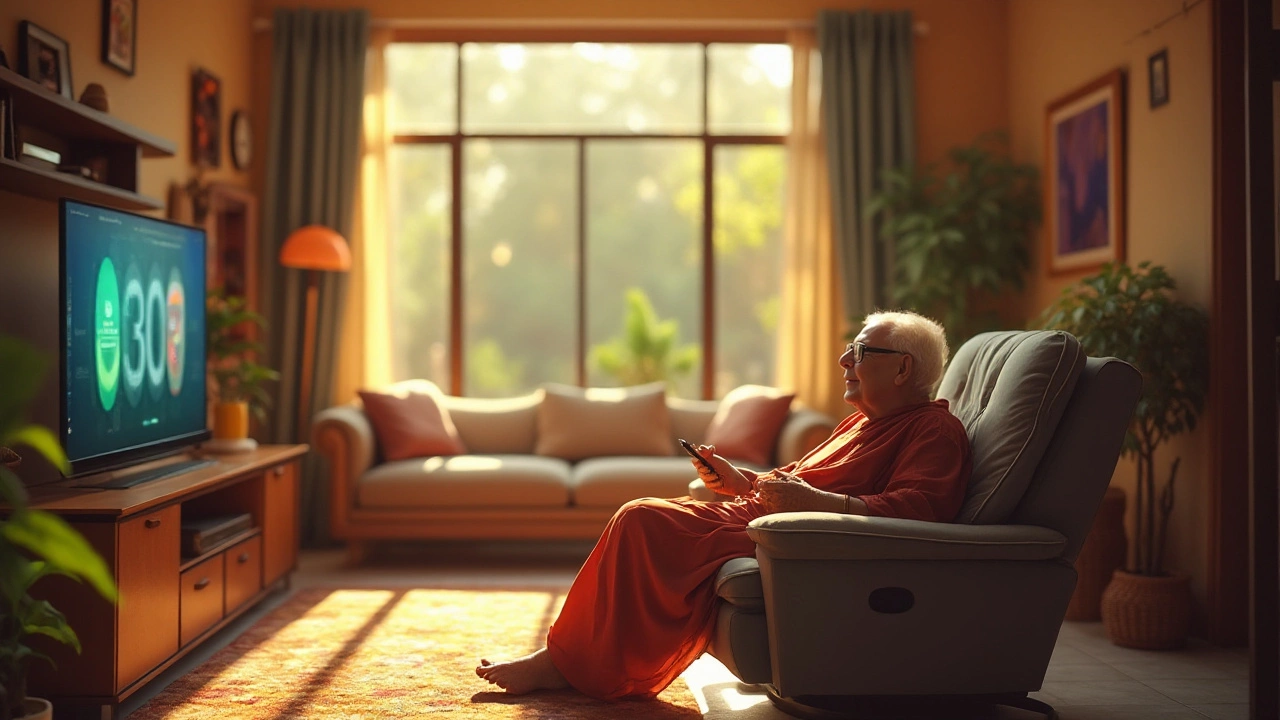
The march towards a smart home isn't just a trend—it's becoming a staple of modern living. In homes across the globe, everyday tasks are being transformed by a wave of intelligent devices that promise convenience and efficiency. But amidst this high-tech revolution, which devices are truly ruling the roost?
As we dive into the world of smart home devices, we'll uncover those that have become household favorites. From the command-giving versatility of smart speakers to the temperature-controlling prowess of thermostats, each device adds a layer of ease to our daily routines. Whether you're a tech enthusiast or just looking to simplify house chores, these gadgets have something to offer.
- The Rise of Smart Home Devices
- Top Devices That Are Taking Over Homes
- The Role of Smart Speakers as Central Hubs
- Innovative Uses of Thermostats in Smart Homes
- Tips for Selecting the Right Smart Device
The Rise of Smart Home Devices
In recent years, the world has witnessed a digital transformation within the comfort of our own homes. It's not merely about convenience; it's a shift in lifestyle that smart home devices offer. From interacting with voice-activated assistants to controlling lights with a simple tap on our phones, the type of connectivity promises a seamless living experience. People are no longer confined to the limits of their immediate space; they can control and manage their homes remotely with the help of these smart home devices. This ease of use fuels their popularity, making these devices a staple in modern homes.
The dawn of smart technology can be attributed to the rapid advancement in internet connectivity and the proliferation of wireless networks. These advancements provide a fertile ground for nurturing ingenious devices that communicate with one another. Back in the early 2000s, such an interconnected ecosystem may have seemed like science fiction. Today, it's a reality that continues to evolve swiftly, thanks to tech giants and innovative startups alike. According to a report by Statista, the global smart home market is projected to reach over 141 billion U.S. dollars by 2027, a sharp increase that underscores society's embrace of intelligent living solutions.
One can't discuss the rise of smart technology without mentioning the smart speakers that have steadily found their way into millions of homes. Devices like Amazon Alexa, Google Home, and Apple HomePod serve as central hubs, showcasing how technology can simplify complex tasks. They offer connectivity, allowing users to synchronize other smart devices for a truly integrated experience; be it scheduling reminders, adjusting thermostats, or managing security systems with just their voice.
"The true value of smart technology lies in its ability to simplify life by automating the mundane and mundane tasks, truly enriching our living environments," tech analyst Jane Foster was quoted as saying during a recent tech conference.
Yet, the journey is far from over. The increasing inclination towards smart homes has initiated a race among manufacturers to produce newer and more capable devices. This competition leads to a continuous improvement in features and capabilities while driving costs down. The integration of artificial intelligence, alongside the improvement in platform interoperability, also continues to pave the way for more intelligent and adaptable products. It's a fascinating journey to observe, where imagination meets innovation, ultimately reshaping how people perceive their living spaces.
Amidst this tech revolution, it's also prudent to consider potential challenges. Security remains a primary concern as the home network gets more extended, opening up multiple entry points for interference. Consumers should be mindful when opting for smart solutions, ensuring their network and devices are well-protected against vulnerabilities. These considerations will likely shape future developments in the smart home ecosystem, demanding robust security protocols from manufacturers alongside enhanced user convenience.
Top Devices That Are Taking Over Homes
Diving into the world of smart homes, one can’t ignore the allure of gadgets that promise both convenience and efficiency, turning our living spaces into tech-savvy havens. At the forefront of this transformation are a slew of smart home devices that have rapidly ascended from novelty to necessity in many households. These aren't just high-tech toys for enthusiasts; they’ve become integral parts of everyday life for many, seamlessly integrating with various aspects of home management. People everywhere are asking not just what these devices are capable of, but how they can best be incorporated into their own routines.
At the heart of many smart homes is the smart speaker, which has become a sort of digital butler, poised to execute commands at a moment’s notice. Brands like Amazon Echo and Google Nest are leading the charge, turning on lights, setting timers, or playing a child's favorite lullaby, just with a voice command. According to a survey by TechUK, nearly 75% of smart home adopters count a smart speaker among their most-used device, appreciating how these units can link other devices together seamlessly. It's not just about playing playlists or setting reminders; these speakers often act as command centers.
"Smart speakers don't just respond to our voices; they orchestrate the symphony of our digital lifestyles," states digital lifestyle expert, Monica Brown.
Besides speakers, smart thermostats are carving out a niche by offering both comfort and control. Devices like the Nest Learning Thermostat analyze a homeowner's patterns and adjust temperatures accordingly, resulting in savings and efficiency. Imagine a world where your home is always maintaining the perfect temperature without you lifting a finger. The Department of Energy reports that smart thermostats can save users up to 10% on heating and cooling bills. The value of this is not just in the immediate savings, but in the way these thermostats teach households to be more energy-conscious without sacrificing comfort.
This transition to smart technology has also opened doors to innovative home-security solutions. Smart locks and video doorbells, like those from Ring and August, have reshaped how we view home security. Now, it’s possible to see who’s at your door from halfway around the world, and let a trusted friend inside with a quick tap on your phone. A recent poll showed that over 60% of smart home device owners rank security enhancement as a major reason for their investment. The integration of cameras with AI to recognize familiar faces or spot unusual activity offers peace of mind that only technology could provide.
Where smart lights were once limited to simple on and off commands, today's systems—like those designed by Philips Hue—provide customizable lighting environments with thousands of color combinations and pre-set scenes that adjust with the sun, mood, or occasion. Lighting can transform a space from work-ready to relaxation-ready, with a simple voice command or tap in an app. About 50% of users reportedly adjust their lighting at least once daily to shift the atmosphere of their home, showcasing the device’s popularity.
The essence of smart home technology lies in its capacity for customization and personalization. As more homes become populated with smart home devices, the potential for creating a fully integrated, intelligent environment becomes palpable—a home that anticipates needs and responds proactively. The impact of these devices isn’t just on comfort, but on how individuals interact with their environment, creating a symbiotic relationship between man and machine. As technology progresses, the imagination is the only limit to what a smart home can achieve.

The Role of Smart Speakers as Central Hubs
Smart speakers have rapidly evolved from simple sound output devices to become the indispensable brains of smart homes. These devices, like the popular Amazon Echo or Google Nest, are not just meant for playing music. They act as central hubs, seamlessly integrating with other smart home devices to automate and enhance domestic life. What makes these speakers unique is their ability to interact with a multitude of devices. From controlling lights and thermostats to even unlocking doors, their versatility is quite astonishing. The integration with voice assistants like Alexa and Google Assistant transforms them into command centers where merely speaking to them can execute an impressive array of tasks.
The evolution of smart speakers is supported by their ability to understand and process voice commands quickly and accurately. Through advancements in artificial intelligence, these speakers are getting smarter, allowing for more intuitive interaction with users. Anyone in the household can ask for the latest news updates, set reminders, or even command the coffee maker to start brewing. It's this integration and simplicity that make them a popular choice for tech-savvy homeowners who seek efficiency and convenience. A user can set up routines such as 'Good Morning,' which, when triggered, could turn on lights, adjust the temperature, and start playing your favorite morning playlist. Clearly, the possibilities only seem limited by your imagination.
A major advantage of smart speakers acting as hubs is how they enable control of a vast array of non-native compatible devices through platforms like IFTTT (If This Then That). This cross-compatibility extends the functionalities and creates a more cohesive smart home network. However, to achieve this, users often rely on multiple brands and systems working harmoniously, and that's where smart speakers excel—they serve as the unified voice or interface for this collaboration. Research reveals that about 58% of smart speaker owners in the U.S. use them to control other smart home devices, according to Voicebot.ai's 2023 survey, highlighting their integral role in home automation.
"Smart speakers have become the backbone of the connected home, primarily due to their user-friendly nature and range of supported devices," says Sarah Johnson, a lead researcher at TechInnovate. "Their design prioritizes user interaction, making it easier for more people to adopt and integrate into their daily lives."
As technology advances, privacy concerns about smart speakers have been on the rise. Users need to be increasingly aware of what information is being collected and how it’s being used. Experts recommend adjusting privacy settings according to personal preferences and ensuring secure and unique passwords or network protections are in place. Ultimately, with the right balance, smart speakers can continue to simplify and enrich our lives without compromising our privacy. The role of these devices as central hubs underscores not just the versatility of smart technology, but also its seamless integration into our everyday environments, making life more connected and intelligent.
Innovative Uses of Thermostats in Smart Homes
In the evolving landscape of smart home technology, the humble thermostat has undergone a transformational makeover. No longer just instruments for adjusting temperatures, smart thermostats have become integral, influencing daily routines and energy consumption patterns. For many, the advent of these devices has been a revelation, offering insights and conveniences that were previously unimaginable. With their ability to connect to your Wi-Fi network, these thermostats can learn your schedule and preferences over time, ultimately optimizing your home environment while saving on energy costs. The most popular thermostats now have sleek designs and intuitive interfaces that blend effortlessly into any home decor, making them both a tech marvel and a stylistic enhancement to your living space.
The Power of Predictive Technology
One of the standout features of modern smart thermostats is their predictive technology capability. It essentially learns when you wake up, leave for work, return home, and go to bed, ensuring your home is always at the perfect temperature without any manual adjustments. This learning ability is powered by advanced machine learning algorithms embedded within the device. But the innovations don’t stop there. These thermostats can also provide detailed reports about your energy usage directly to your smartphone, helping you identify habits that lead to increased energy consumption. By making simple adjustments based on this feedback, homeowners can significantly lower their utility bills.
"The capability of smart thermostats to adapt and optimize energy use is revolutionary. It not only offers convenience but also a pathway to sustainability," says renowned tech analyst Xavier Hale.
Beyond Basic Climate Control
Smart thermostats are part of a broader ecosystem of smart home devices, connecting seamlessly with other technologies in your home. Imagine a thermostat communicating with your smart blinds to let in the morning sun when it senses you're starting to wake up, or collaborating with your smart lighting system to reduce glare during the hottest parts of the day. This type of inter-device communication represents the next wave of innovation in home automation. Moreover, the integration of voice assistant technology like Amazon Alexa or Google Assistant with smart thermostats has further amplified their utility. This means homeowners can make hands-free adjustments simply by voicing their commands. It is not just about convenience; it’s about creating a personalized atmosphere tailored to your every whim.
Staying Ahead with Software Updates
Another aspect of these devices is their ability to evolve even after purchase. Regular software updates ensure your thermostat keeps up with the latest trends in smart home technology and maintains robust security. Manufacturers often release updates that tweak algorithms or improve the user interface based on customer feedback. This means that the device continues to remain cutting-edge long after it has been installed in your home. In some cases, these updates can add entirely new functionalities, further increasing the value of your investment. However, it is essential also to consider compatibility with your existing systems. Ensuring a smart thermostat works well with the other devices within your home ecosystem is paramount to achieve the maximum potential of this technology.
Energy Efficiency: A Key Advantage
The push towards energy efficiency is one of the most critical drivers of smart thermostat adoption. According to a study by the Smart Energy Consumer Collaborative, smart thermostats can lead to energy savings ranging from 10% to 20% on heating and cooling costs. Such savings translate into substantial financial benefits over time, making these devices attractive even to those who may not initially be swayed by technological allure. Additionally, the environmental benefits of reducing your carbon footprint can have a significant positive impact, making smart thermostats not just a convenience, but a responsible choice. Homeowners increasingly prioritize sustainability, and smart thermostats align perfectly with this ethos, providing a tangible way to contribute to environmental preservation while also caring for comfort and cost-efficiency.

Tips for Selecting the Right Smart Device
Choosing the right smart home devices can be quite a task given the plethora of options available in today's market. Every gadget promises to revolutionize your home life with convenience and innovation, but not every device will suit your specific needs. To make the best choice, it's essential to consider several factors before making a purchase. First, assess your personal requirements. Think about the areas in your home life where technology could bring noticeable improvements. Whether it's boosting security, enhancing entertainment, or managing the environment, understanding your needs should dictate the type of devices to explore. For instance, if you're keen on energy savings and maintaining a comfortable home climate, a smart thermostat might just be your winning ticket. But if multifaceted control is what you seek, smart speakers like Amazon Alexa or Google Home could serve as your home's command center.
Compatibility is another vital consideration. Make sure the smart device you choose works seamlessly with other devices you already own or plan to purchase. This involves checking if they operate on the same platform or ecosystem. Some users prefer devices that are cross-compatible, varying from Apple HomeKit, Amazon Alexa, or Google Assistant, so they can maintain some flexibility. Determining compatibility can save you future headaches down the line. Also, keep in mind how these devices can grow with you. Investing in gadgets that can receive regular updates and integrate with future technologies ensures that your smart home stays relevant and functional.
When it comes to smart home devices, simplicity and usability should never be overlooked. A device that's complex and difficult to operate won't help you much, regardless of its features. Look for devices with intuitive interfaces, easy setup processes, and responsive customer support. Checking user reviews is a smart step to see how real-world operation pans out.
"The easiest technology to use is also the most effective," says tech expert John C. Dvorak, highlighting that practicality in use often trumps sophisticated but cumbersome tech. As you might find, speaking with peers who have similar setups can offer insightful pointers on user-friendliness.
Cost vs. value might be one of the most challenging assessments. Initially, many smart devices appear to be on the high-end spectrum, but they're often designed to offer long-term benefits in cost savings, convenience, or security. Weighing these against your budget can guide you in deciding what represents good value. Seasoned smart home users often suggest starting with devices that have multiple functions. Multi-purpose products, such as smart lighting systems that integrate with motion sensors and security features, provide broader functionality out of a single investment. This way, you benefit from layered use cases while keeping your expenditure in check.
It's interesting to note some statistical insights on smart home purchases. According to a recent survey by Statista, around 33% of consumers prioritize purchasing devices that offer security features, becoming the lead driver in buying decisions. Such stats not only depict trends but can aid you in aligning your needs and preferences against market data. Additionally, environmental impact is gaining traction as a selection criterion. Individuals are increasingly seeking eco-friendly smart devices; hence, those emphasizing energy efficiency or sustainability could be worth exploring. So, take your time, investigate your options, and remember: the best devices are those that suit your home's uniqueness and align with how you wish to interact with your living space.